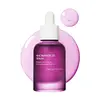What's inside
What's inside
 Key Ingredients
Key Ingredients

 Benefits
Benefits

 Concerns
Concerns

No concerns
 Ingredients Side-by-side
Ingredients Side-by-side

Water
Skin ConditioningNiacinamide
SmoothingPropanediol
SolventButylene Glycol
HumectantTranexamic Acid
Astringent1,2-Hexanediol
Skin ConditioningHydroxyacetophenone
AntioxidantAcrylates/C10-30 Alkyl Acrylate Crosspolymer
Emulsion StabilisingGlycereth-25 PCA Isostearate
EmulsifyingArginine
MaskingEthylhexylglycerin
Skin ConditioningGardenia Florida Fruit Extract
Skin ConditioningDextrin
AbsorbentTrisodium Ethylenediamine Disuccinate
Glycerin
HumectantZea Mays Kernel Extract
Dipropylene Glycol
HumectantGlutathione
Hyaluronic Acid
HumectantHydrogenated Lecithin
EmulsifyingHydrolyzed Hyaluronic Acid
HumectantSodium Hyaluronate
HumectantPolyglyceryl-10 Oleate
Skin ConditioningAsiaticoside
AntioxidantHedera Helix Extract
AntimicrobialMadecassic Acid
Skin ConditioningAsiatic Acid
Skin ConditioningFructan
Skin ConditioningGlucose
HumectantPaeonia Suffruticosa Root Extract
Skin ProtectingPortulaca Oleracea Extract
Skin ConditioningAllantoin
Skin ConditioningHexylresorcinol
AntimicrobialArtemisia Princeps Leaf Extract
Skin ConditioningRhodiola Rosea Root Extract
EmollientWater, Niacinamide, Propanediol, Butylene Glycol, Tranexamic Acid, 1,2-Hexanediol, Hydroxyacetophenone, Acrylates/C10-30 Alkyl Acrylate Crosspolymer, Glycereth-25 PCA Isostearate, Arginine, Ethylhexylglycerin, Gardenia Florida Fruit Extract, Dextrin, Trisodium Ethylenediamine Disuccinate, Glycerin, Zea Mays Kernel Extract, Dipropylene Glycol, Glutathione, Hyaluronic Acid, Hydrogenated Lecithin, Hydrolyzed Hyaluronic Acid, Sodium Hyaluronate, Polyglyceryl-10 Oleate, Asiaticoside, Hedera Helix Extract, Madecassic Acid, Asiatic Acid, Fructan, Glucose, Paeonia Suffruticosa Root Extract, Portulaca Oleracea Extract, Allantoin, Hexylresorcinol, Artemisia Princeps Leaf Extract, Rhodiola Rosea Root Extract
Water
Skin ConditioningButylene Glycol
HumectantGlutathione
Pentylene Glycol
Skin ConditioningHydrogenated Lecithin
EmulsifyingSodium Hyaluronate
HumectantSqualane
EmollientGlycerin
HumectantHydroxypropyl Methylcellulose Stearoxy Ether
Tocopherol
AntioxidantCellulose Gum
Emulsion StabilisingDiospyros Kaki Fruit Extract
Skin ConditioningNeopentyl Glycol Dicaprate
EmollientSaccharomyces Cerevisiae Extract
Skin ConditioningPolyglyceryl-10 Eicosanedioate/Tetradecanedioate
Skin ConditioningSodium Lactate
BufferingPotassium Hydroxide
BufferingPolyacrylate Crosspolymer-6
Emulsion StabilisingCarbomer
Emulsion StabilisingT-Butyl Alcohol
Perfuming1,2-Hexanediol
Skin ConditioningCaprylyl Glycol
EmollientPEG-60 Hydrogenated Castor Oil
EmulsifyingPhenoxyethanol
PreservativeParfum
MaskingWater, Butylene Glycol, Glutathione, Pentylene Glycol, Hydrogenated Lecithin, Sodium Hyaluronate, Squalane, Glycerin, Hydroxypropyl Methylcellulose Stearoxy Ether, Tocopherol, Cellulose Gum, Diospyros Kaki Fruit Extract, Neopentyl Glycol Dicaprate, Saccharomyces Cerevisiae Extract, Polyglyceryl-10 Eicosanedioate/Tetradecanedioate, Sodium Lactate, Potassium Hydroxide, Polyacrylate Crosspolymer-6, Carbomer, T-Butyl Alcohol, 1,2-Hexanediol, Caprylyl Glycol, PEG-60 Hydrogenated Castor Oil, Phenoxyethanol, Parfum
Ingredients Explained
These ingredients are found in both products.
Ingredients higher up in an ingredient list are typically present in a larger amount.
1,2-Hexanediol is a synthetic liquid and another multi-functional powerhouse.
It is a:
- Humectant, drawing moisture into the skin
- Emollient, helping to soften skin
- Solvent, dispersing and stabilizing formulas
- Preservative booster, enhancing the antimicrobial activity of other preservatives
Butylene Glycol (or BG) is used within cosmetic products for a few different reasons:
Overall, Butylene Glycol is a safe and well-rounded ingredient that works well with other ingredients.
Though this ingredient works well with most skin types, some people with sensitive skin may experience a reaction such as allergic rashes, closed comedones, or itchiness.
Learn more about Butylene GlycolGlutathione is an antioxidant naturally found in our bodies. It is made up of three amino acids: glycine, cysteine, and glutamic acid.
As an antioxidant, it prevents oxidative damage to parts of our cell.
While glutathione is said to help with fading dark spots, the results from research are inconclusive. Further studies are needed. With that said, gluthatione has been shown to protect our skin from UV-B induced damage.
This ingredient is naturally occurring in plants, animals, fungi, and some bacteria.
Learn more about GlutathioneGlycerin is already naturally found in your skin. It helps moisturize and protect your skin.
A study from 2016 found glycerin to be more effective as a humectant than AHAs and hyaluronic acid.
As a humectant, it helps the skin stay hydrated by pulling moisture to your skin. The low molecular weight of glycerin allows it to pull moisture into the deeper layers of your skin.
Hydrated skin improves your skin barrier; Your skin barrier helps protect against irritants and bacteria.
Glycerin has also been found to have antimicrobial and antiviral properties. Due to these properties, glycerin is often used in wound and burn treatments.
In cosmetics, glycerin is usually derived from plants such as soybean or palm. However, it can also be sourced from animals, such as tallow or animal fat.
This ingredient is organic, colorless, odorless, and non-toxic.
Glycerin is the name for this ingredient in American English. British English uses Glycerol/Glycerine.
Learn more about GlycerinHydrogenated Lecithin is created from the hydrogenation of lecithin (a group of phospholipids). Hydrogenation is a chemical reaction between hydrogen and another element.
This ingredient is an emollient and emulsifier. As an emollient, it helps soften skin by trapping moisture within. As an emulsifier, it prevents oil and water ingredients from separating.
Sodium Hyaluronate is hyaluronic acid's salt form. It is commonly derived from the sodium salt of hyaluronic acid.
Like hyaluronic acid, it is great at holding water and acts as a humectant. This makes it a great skin hydrating ingredient.
Sodium Hyaluronate is naturally occurring in our bodies and is mostly found in eye fluid and joints.
These are some other common types of Hyaluronic Acid:
Learn more about Sodium HyaluronateWater. It's the most common cosmetic ingredient of all. You'll usually see it at the top of ingredient lists, meaning that it makes up the largest part of the product.
So why is it so popular? Water most often acts as a solvent - this means that it helps dissolve other ingredients into the formulation.
You'll also recognize water as that liquid we all need to stay alive. If you see this, drink a glass of water. Stay hydrated!
Learn more about Water